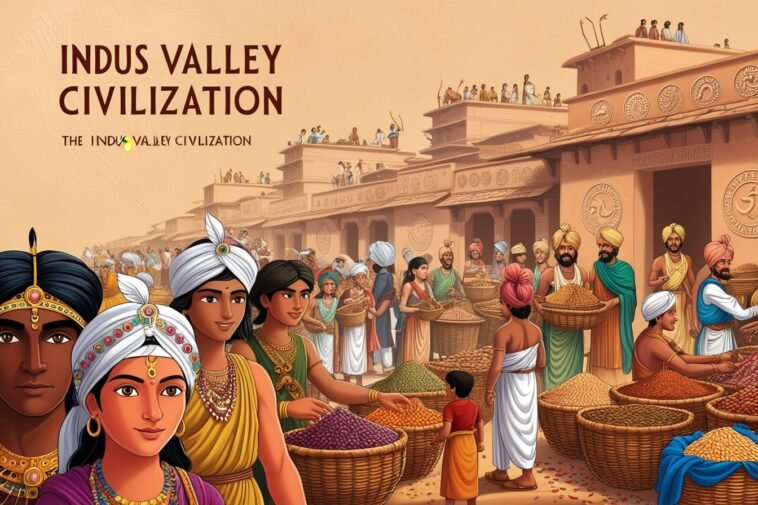
The world’s history is filled with lost civilizations that thrived in ways we may never fully understand.
Each of these ancient societies left behind artifacts, structures, and sometimes even entire cities that provide tantalizing glimpses into their lives.
But much remains unknown, and their sudden disappearances still puzzle archaeologists and historians today.
This article will take you through the mysteries and discoveries of 10 fascinating lost civilizations.
The Indus Valley Civilization
The Indus Valley Civilization, or Harappan Civilization, was a highly advanced society that thrived between 3300 and 1300 BCE in areas that are now Pakistan and northwest India.
Known for their impressive city planning, the people of the Indus Valley built cities like Harappa and Mohenjo-Daro with organized layouts, efficient drainage systems, and large storage buildings, like granaries.
What we know
The Indus Valley cities had a structured, organized design and evidence of trade with Mesopotamia.
Archaeologists have found standardized weights and various forms of artwork, showing that the civilization had a strong economy and a sense of cultural expression.
What we don’t know
Despite these advancements, many aspects of the Indus Valley remain a mystery.
We haven’t yet deciphered their writing system, known as the Indus script, so their language, culture, and beliefs are still unknown.
We also aren’t certain why the civilization declined around 1300 BCE, though possible reasons include climate change or invasions from other groups.
The Minoan Civilization

The Minoan Civilization thrived on the island of Crete from around 2600 to 1100 BCE and is often recognized as one of Europe’s first major civilizations.
They had a strong influence across the Aegean Sea, shaping early Mediterranean culture.
What we know
The Minoans were skilled in craftsmanship and trade.
Their palaces, like the one at Knossos, reveal impressive architectural abilities.
Minoan art, especially their detailed frescoes, shows a society that valued beauty and leisure.
They were also among the first to develop a writing system, known as Linear A.
What we don’t know
Much of Minoan culture remains a mystery because we haven’t deciphered Linear A, their written language.
This makes it hard to understand their religion and some aspects of their daily life.
We’re also unsure why the civilization declined, though a massive volcanic eruption on the nearby island of Thera (Santorini) around 1600 BCE may have contributed to their downfall.
The Mycenaean Civilization
The Mycenaean Civilization was a dominant force in Greece from around 1600 to 1100 BCE.
They are often linked to the legendary heroes from Homer’s epic poems, The Iliad and The Odyssey, which feature stories of war and adventure.
What we know
The Mycenaeans were known for their impressive palaces, such as those at Mycenae and Tiryns, and their expertise in metalworking.
Their writing system, called Linear B, has been partially decoded, providing insights into their administrative practices, such as record-keeping and trade.
What we don’t know
Despite their accomplishments, the cause of the Mycenaeans’ sudden collapse around 1100 BCE remains a mystery.
Some theories suggest invasions by the Sea Peoples, a group of mysterious warriors, or that internal problems, such as earthquakes or social unrest, may have led to their downfall.
The Khmer Empire

The Khmer Empire was a powerful civilization that thrived in Southeast Asia from the 9th to the 15th centuries, with its heart in what is now Cambodia.
The empire played a key role in shaping the history of the region and left behind impressive legacies.
What we know
The Khmer Empire is most famous for creating Angkor Wat, the largest religious monument in the world, which still stands today as a testament to their architectural and engineering skills.
At its peak, the empire controlled much of Southeast Asia, and the Khmer people were highly advanced in water management.
They developed complex irrigation systems that helped them grow crops and manage floods, ensuring the empire’s agricultural success.
What we don’t know
While the Khmer Empire was a dominant force for centuries, the reasons for its decline are still not fully understood.
Some historians believe that climate change, which may have led to water shortages, played a role in weakening the empire.
Others suggest that internal conflicts, such as social unrest or warfare, contributed to its downfall.
Despite these theories, the exact cause remains a subject of debate among scholars.
The Maya Civilization
The Maya civilization began around 2000 BCE and reached its peak between 250 and 900 CE in what is now Mexico, Guatemala, and Belize.
This civilization is known for its incredible achievements in various fields and remains one of the most fascinating ancient cultures.
What we know
The Maya are famous for creating a sophisticated hieroglyphic script, which was used to record important events and information.
They also developed an advanced calendar system that showed their deep understanding of time and astronomy.
The Maya built impressive architectural structures, such as the iconic pyramid at Chichen Itza.
Their skills in mathematics and astronomy were remarkable, and they left behind extensive records of their knowledge and achievements.
What we don’t know
Despite our knowledge of many aspects of Maya society, the reason behind the decline of the Classic Maya civilization around 900 CE is still uncertain.
Scholars believe it could have been caused by a combination of factors, such as warfare between city-states, a severe drought that affected resources, or the depletion of vital natural resources.
However, no single explanation has been proven, and the exact cause of their collapse remains a subject of ongoing research and debate.
The Nazca Civilization

The Nazca civilization flourished on the southern coast of Peru between around 100 BCE and 800 CE.
It is most famous for the mysterious Nazca Lines, large geoglyphs that can still be seen in the desert today.
What we know
The Nazca were highly skilled in creating an advanced irrigation system, which allowed them to thrive in a region with little rainfall.
They also produced beautiful pottery and textiles, showcasing their craftsmanship.
However, their most famous legacy is the Nazca Lines—massive images etched into the desert floor, depicting animals, shapes, and patterns.
These geoglyphs are one of the most enduring symbols of the civilization.
What we don’t know
The purpose of the Nazca Lines remains a mystery.
Some theories suggest they were religious offerings or were used for astronomical purposes, but no one knows for sure.
The reason for the decline of the Nazca civilization is also unclear.
While some experts believe it may have been caused by a prolonged drought, this theory remains speculative, and other factors could have played a role in their decline.
The Dwarka Civilization
The ancient city of Dwarka, believed to be around 9,000 years old, is closely linked to Hindu mythology and the god Krishna.
For a long time, Dwarka was considered a legend until its ruins were discovered underwater off the coast of Gujarat, India.
What we know
Archaeological discoveries suggest that Dwarka may have been a prosperous and important city, possibly a major trading hub in ancient times.
The remains of harbors and well-constructed buildings found at the site indicate advanced engineering and a thriving community.
What we don’t know
The exact timeline of Dwarka’s existence and the reasons behind its submersion are still unclear.
Scholars continue to debate whether Dwarka was a real historical city or if it was mainly a myth.
Additionally, the dating of the ruins and artifacts found at the site still requires further study and verification to fully understand its history.
The Vinland Culture

The Vinland Culture refers to the Norse settlements established by Leif Erikson around 1000 CE in a region they called “Vinland,” which is believed to be located in North America.
What we know
Archaeological evidence, such as the site at L’Anse aux Meadows in Newfoundland, confirms that the Norse reached North America long before Columbus.
The site shows that the Norse had a small but active settlement, with various artifacts suggesting they lived and worked there for a time.
What we don’t know
The reasons for the Norse abandoning Vinland are still unclear.
There are several theories, including possible conflicts with indigenous people, difficulties in sustaining the settlement in a harsh environment, or a lack of resources.
However, the exact cause remains a topic of speculation and debate among historians.
The Kingdom of Mu
The Kingdom of Mu is a theorized lost continent that some believe once existed in the Pacific Ocean and sank beneath the sea thousands of years ago.
While there is no archaeological evidence to support this theory, it continues to capture the imagination of many.
What we know
The idea of Mu was popularized in the 19th century by James Churchward, who claimed that it was a highly advanced civilization, similar to the myth of Atlantis.
According to Churchward, Mu was a place of great technological achievements and wisdom.
What we don’t know
Despite its popularity, Mu remains a legend.
There is no solid evidence to confirm the existence of the continent, and most scientists consider the theory to be pseudoscience.
Nevertheless, the mystery of Mu still fascinates researchers and explorers, who continue to look for any proof that such a civilization might have once existed.
Çatalhöyük

Çatalhöyük, located in modern-day Turkey, was a large Neolithic settlement that dates back to around 7500 BCE, making it one of the earliest known urban centers in history.
What we know
The people of Çatalhöyük lived in closely packed mud-brick houses, with entrances through the roofs instead of doors at ground level.
This unique layout suggests an innovative approach to urban planning.
Archaeologists have also uncovered various artifacts and wall paintings, which show that the people of Çatalhöyük had a rich cultural and spiritual life, with a strong focus on art and possibly religious practices.
What we don’t know
The social structure of Çatalhöyük is still a mystery.
Unlike other ancient societies, there’s no clear evidence of a formal hierarchy or centralized government.
This has led to debates about how the society was organized. Additionally, the reasons behind its eventual decline and abandonment remain unclear, with no definitive answers yet as to what led to the end of this fascinating settlement.
Final Thoughts
These ancient civilizations leave us with both awe and curiosity.
Their remarkable accomplishments inspire us, yet they also remind us of how easily societies can fade over time.
Although many questions about these cultures remain unanswered, continued archaeological work could one day unlock the secrets they left behind.



